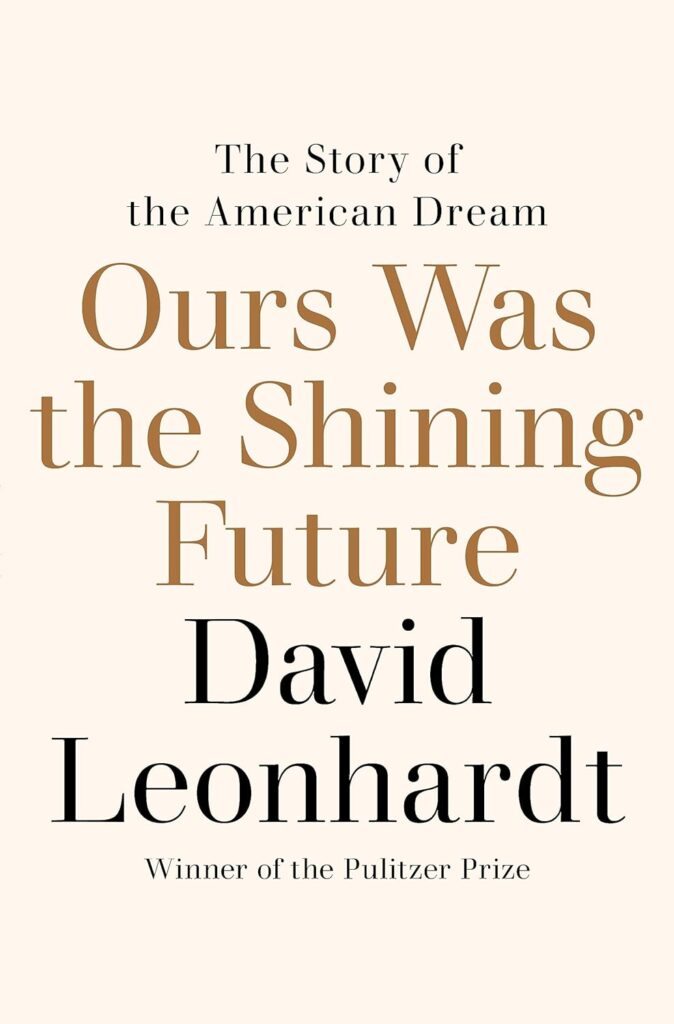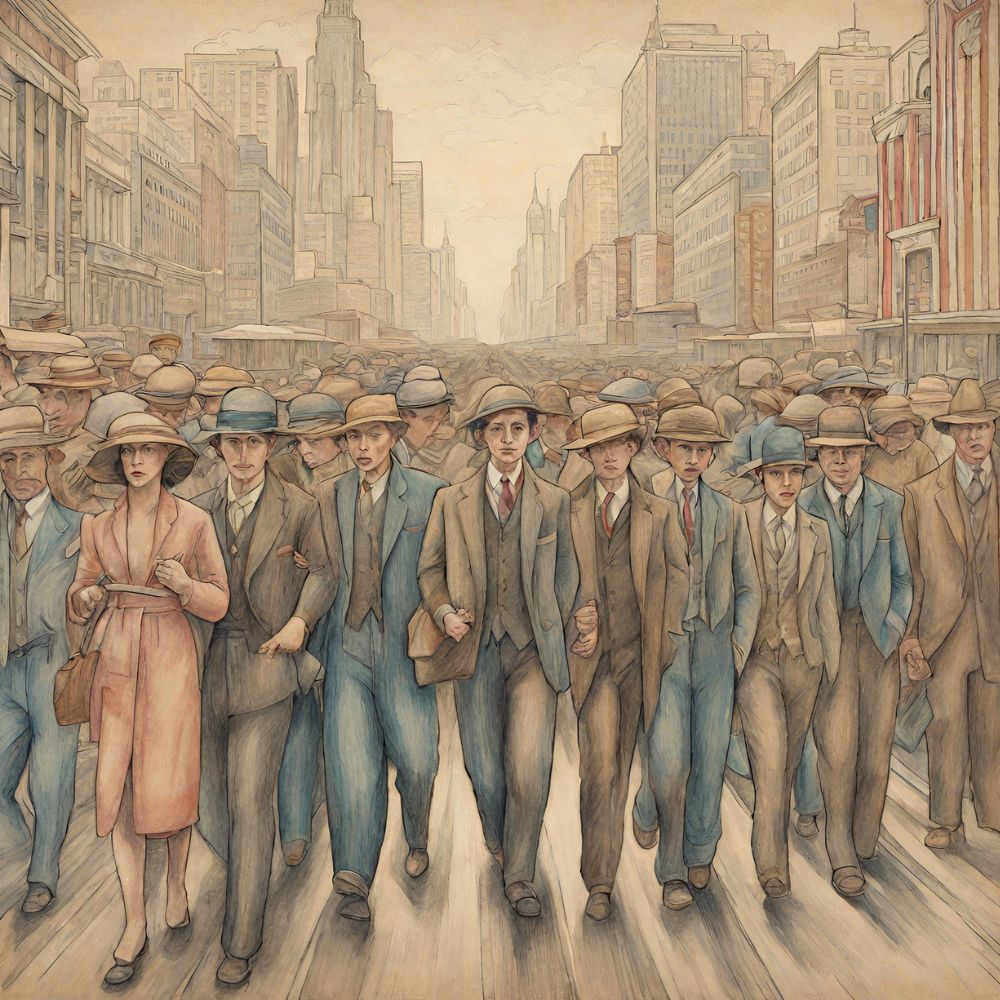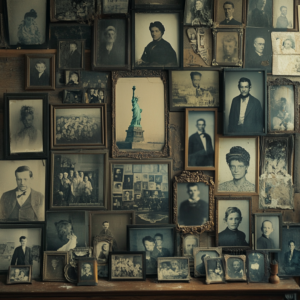
Highly Recommended:
Ours Was the Shining Future: The Story of the American Dream, by David Leonhardt
Many of the insights in this article come from David Leonhardt’s book which we highly recommend. We may earn commission through partner links.
The concept of the “American Dream” is deeply ingrained in the fabric of American society. It’s a phrase that has been used for nearly a century to encapsulate the aspirations, hopes, and beliefs that drive people to seek a better, richer, and happier life in the United States. The term, “the American Dream,” has an intriguing history, and it’s fascinating to explore its origins and how it has evolved over time. David Leonhardt’s description in his book “Ours was The Shining Future: The Story of The American Dream” provides valuable insights into the roots of this enduring concept. One of the pivotal moments in its early history is the publication of James Truslow Adams’ 1931 book, “The Epic of America,” which helped crystallize the idea of the American Dream during a time of great economic adversity.
The Great Depression and “The Epic of America”
In 1931, the United States was mired in the depths of the Great Depression, one of the most challenging economic crises in the nation’s history. It was during this trying period that historian James Truslow Adams published his seminal work, “The Epic of America.” This book would become a bestseller and would play a crucial role in popularizing the concept of the American Dream.
Adams, who had already won a Pulitzer Prize for his first book, penned a compelling vision of the American Dream in “The Epic of America.” His definition was simple yet profound: the American Dream was “the notion of a better, richer, happier life for all citizens of every rank.” What makes this even more remarkable is that he presented this vision during a time when the nation was grappling with economic hardship and despair. Adams acknowledged the challenges but maintained that this aspiration for a better life was fundamental to American ideals.
This definition captured the essence of what the American Dream represented. It was not solely about material wealth or individual success but about the opportunity for every citizen, regardless of their background, to achieve a higher quality of life. It was a vision of progress, equality, and the pursuit of happiness that transcended the economic difficulties of the time.
Roots of the American Dream
To understand the origins of the American Dream, we must delve even further back into American history. The concept has deep-rooted connections to the nation’s founding principles and the idea of America as a land of opportunity.
- Founding Principles: The American Dream finds its roots in the ideals upon which the United States was founded. The Declaration of Independence famously enshrines the pursuit of happiness as one of the unalienable rights of all citizens. This pursuit is a central theme of the American Dream, emphasizing the individual’s ability to strive for a better life and fulfill their potential.
- Immigration and Opportunity: A significant factor that contributed to the American Dream’s development was the wave of immigration in the late 19th and early 20th centuries. Millions of people from various corners of the world sought refuge and a fresh start in the United States, driven by the promise of economic opportunity and freedom.
- Westward Expansion: The idea of westward expansion and the frontier played a vital role in shaping the American Dream. The notion that one could venture into uncharted territories, stake a claim, and build a better life embodied the spirit of the dream.
- Economic Prosperity: The American Dream was closely tied to the economic prosperity that the nation experienced throughout the 19th and early 20th centuries. Industrialization, technological advancements, and the rise of the middle class all contributed to the belief that upward mobility and success were within reach.
Evolution of the American Dream
The American Dream has evolved over time, reflecting the changing dynamics of American society, politics, and economics. While James Truslow Adams’ definition from 1931 was influential, the dream has continued to adapt and grow. Here are some key stages in its evolution:
- Post-World War II Prosperity: The end of World War II marked a period of remarkable economic growth and prosperity in the United States. The American Dream of this era included suburban homeownership, a secure job, and the ability to provide a better future for one’s children. The idea of a “white picket fence” and a stable, middle-class life became emblematic of this era.
- Civil Rights and Social Justice: The civil rights movement in the 1960s expanded the American Dream’s definition to include social justice and equal opportunities for all. It became a vision that encompassed not only material success but also the elimination of racial and social disparities.
- Economic Challenges and Inequality: The late 20th century and early 21st century have seen challenges to the American Dream. Economic inequality, the Great Recession of 2008, and the increasing cost of education have raised questions about the dream’s attainability for all. These challenges have prompted discussions about the need for reform and a more equitable society.
- Globalization and Immigration: As the world has become more interconnected, the American Dream has taken on a global dimension. It’s not just about what individuals can achieve within the United States but also about the opportunities available to immigrants and people seeking a better life in America.
The American Dream, with its origins in the founding principles of the United States, has been a driving force in American society for nearly a century. James Truslow Adams’ 1931 book, “The Epic of America,” played a pivotal role in defining and popularizing the concept during a time of great economic adversity, the Great Depression. Its evolution over time reflects changes in the nation’s economic, social, and political landscape.
While the American Dream has faced challenges and adaptations, its enduring appeal lies in the promise of a better, richer, and happier life for all citizens, regardless of their background or circumstances. As the United States continues to navigate the complexities of the modern world, the American Dream remains a symbol of hope, opportunity, and the pursuit of a brighter future. It’s a dream that continues to inspire and drive the American people forward.
Also Read: The American Dream is… Overseas Hiring? A concerning trend in the EOR industry reveals that American companies are increasingly hiring for senior roles overseas.







